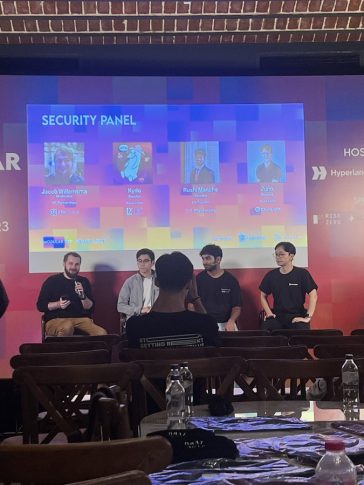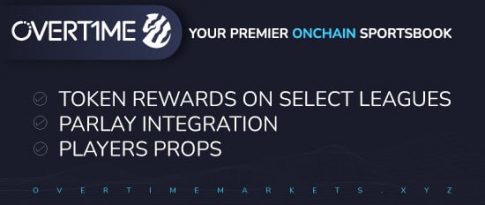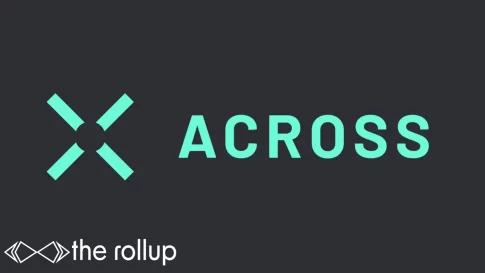
Exploring Layer Two Security and Data Availability
NFL Season is available to trade on Overtime – Sports market AMM built on Thales Market, a Synthetix ecosystem project. Earn your share of 90k $OP, 90k ARB, and 180k $THALES in incentives. Try it 👉🏽 HERE!
AcrossProtocol is a cross-chain bridge for L2s and rollups secured by UMA’s optimistic oracle that prides itself on its speed, security and low fees. Check it 👉🏽 HERE.
High Rollers:
Dive into the intricate world of blockchain security with this recap of the Hyperlane and Celestia Modular Day panel at EFDevconnect.
The panel, featuring Kydo of Eigen Layer, Juno Rouse of Chain Light, and Rushi Manche of Movement Labs, delved into the complexities of layer two security and data availability.
The discussion, moderated by Jacob from ETHGlobal, touched on a range of topics from the role of data availability and sequencers to the future of smart contract security in a world of modular chains.
Read on to explore the insights and perspectives shared by these industry experts as they navigated the evolving landscape of blockchain security.
Cheers,
The Rollup
Security panel at Hyperlane and Celestia Modular Day!
Featuring Kydo of Eigen Layer, Juno Rouse of Chain Light & Rushi Manche of Movement Labs.

Another EFDevconnect panel live recap, here we go 👇
First question from moderator Jacob, of ETHGlobal is about layer two security and data availability security.
Kydo begins with data availability and ‘AltDA’ which is separate from posting call data on Ethereum.
Kydo explains there are new complexities added with this model
He goes on to explain decentralization of sequencers is an interesting proposition as well.
Moderator Jacob asks about posting call data to “why do we have to do anything with data? Why do we have to put it somewhere?”
Kydo answers that DA guarantee prevents a centralized party from withholding data.
Also that you inherit the base security properties of Ethereum as well, with altDA there are underlying trust assumptions for Eigen Layer and Celestia which are separate from Ethereum.
This is the trade off from using a DA layer vs Ethereum itself Rushi anche
asks:
How do these new DA layers play a part with danksharding coming up?
Kydo says he’s not a DA guy 😂😂 but is at Eigenlayer and that users are here, and they want danksharding now
In between the time to EIP4844, he explains how different DA solutions are needed imminently.
Jacob guides the conversation with “who’s checking for correctness of the data and what is a watch tower?”
Watch tower is a key component in the stack which observes a L2 chains to detect when a fraud is happening to kick start the fraud proof window on L1.
Kydo explains that this is currently handled by centralized sequencers now which is looking to be decentralized in the near future
Juno then replies how each protocol in crypto is monitored by some other 3rd party (like ChainLight)
This is for security to prevent bad actors
Juno explains how arbitrum governance is ran by validators should have the ability to create transactions to suggest a challenge period or fraudulent tx
On arbitrum, there’s not enough validators who have enough ETH to submit TXs let alone challenge a tx and start a fraud proof.
Jacob asks how we setup validators to secure thousands of chains in the future if we struggle to do so with dozens now…
Juno adds that Eigen Layer is doing well on this.
We start diving into the setup of security of sequencers right now.
Rushi said it’s awful. Mentions that downtime is very problematic for rollups and that shared sequencers are great but economic incentives need to be aligned for rollups to change their current ways.
He mentions that @CeloOrg has a very unique tokenomics mechanism for securing their chain via their validator set being a part of the shared sequencer model.
It’s been very cool to see how Celo has transitioned to an L2 with this “hybrid” type model.
We did a fun pod recently too. You can listen to it here.
Kydo steps in to “defend” L2s and suggests new terminology of distributed systems as rollups as they are now, but he agrees that in future from a liveness + regulatory POV, a set of decentralized nodes is very important.
Jacob asks if there’s any thoughts how these chains develop over time with smaller revenue and more decentralization?
Rushie suggests that the decline in sequencer profits will not make sense in the long term, as DA layers will be utilized and tx fees will be much cheaper.
He mentions at this point in time, when fees are significantly cheaper, using a decentralized sequencer makes a ton more sense
Now moving into modular blockchain discussion…
Jacob asks how smart contract security will change in a world of modular chains with 1000s of different layers/chains/tools?
Juno replies that he thinks smart contract security will not change dramatically from where we are now to a certain extent
He then explains optionality
And how optionality, given a set of solid contracts from different parts of the stack so to speak, will enable easier creation of modular chains
Jacob mentions that “it’ll be good for business” 😂😂🤓
Yes moar chains pls auditors are rejoicing!!
Next topic: solidity.
Rushi is so ready to tackle this. First, he touches on MoveVM and how it’s interesting that modular has different use cases for the thesis of each project.
Rushi states that security is the biggest issue right now – he uses an example that “Bank of America” won’t use solidity as its potential for hacks is an issue.
He mentions that they are very focused on building secure, reliable tech.
The thesis of alt-VMs is exciting.
Rushi mentions further that these VMs can empower “bulletproof rollups” using Ethereum as settlement, an altVM for execution, and a separate DA layer gets you a modular rollup with tons of use cases.
Also, he added that Rust based VMs are extremely exciting (rust is a coding language which is popular amongst devs in ‘web2’)
He thinks the moveVM is great because of formal verification embedded natively.
Juno asks a question ab formal verification, and Rushi explains that technicals behind MoveVM and how the bytecode works with its smart contract execution when compared to solidity and EVM
Rushi taking shots at EVM, what’s new?😂
The panel concludes “move is very cool” hahaha
Jacob pushes forward with a short recap of the panel thus far and another question: “what’s missing from the current convo?”
Rushi asks about slashing with eigenlayer
Kydo answers that slashing is not live yet, but will be on eigenlayer and explains how PoS chains incentivize actors to not act against the rules of the network
He then explains how Eigenlayer abstracts this into its smart contracts for devs to build atop with it embedded
Jacob asks a question about security and fragmentation vs shared security
Kydo replies about the differences in these models & how the economic relationship is unique
He explains in this new world of shared security, you must spend much more $$$ to compromise a rollup.
Jacob says we’ve used every buzzword possible in this talk😂😂 so true
So what’s next? Of course ‘zk’
Kydo says zk is a great add on and zk is a great future usecase but is also focused on security now
He explains how zksync proof mechanisms do a great job at both, currently.
Rushi says basically zk is cool, but prover costs are quite high.
He mentions polygon cdk is interesting because you can share proving costs amongst tons of rollups and effectively socialize the costs (and liquidity, if I’m not mistaken)
Oh boy, Juno says they found a circuit bug in zksync …….Chain Light?
He says the focus should be on a safe, secure environment.
zk coding is very difficult and is still very novel, tread carefully frens
Jacob recaps the panel with the security-based mindset going forward and hopes for safe, secure programming and that’s all folks!
Thanks for reading – hope you enjoyed this Devconnect panel recap.
🙌 Together with:
Connext – Build Web3 applications that can securely interact with users, tokens, and other applications on any chain – just like on the web. Learn more here.
Jumper Exchange A truly multi-chain exchange. Aggregating the best in the business for bridging, swapping, and onramping. Learn more here.
Cartesi is an application-specific rollup protocol with a Linux runtime. Scaling Computation. Transcending EVM Limitations. Learn more here.
Disclaimer: Please be aware that investing in cryptocurrency and DeFi platforms involves risks like technical glitches and human errors. We may receive commissions for featuring certain projects, which will be clearly noted. Our content is educational only and not financial advice; we are not licensed advisors.







